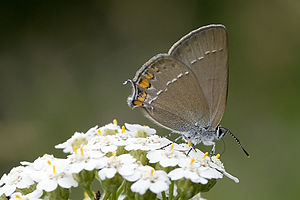Little sloe hairstreak
| Little sloe hairstreak | ||||||||||||
|---|---|---|---|---|---|---|---|---|---|---|---|---|

Little sloe hairstreak ( Satyrium acaciae ) |
||||||||||||
| Systematics | ||||||||||||
|
||||||||||||
| Scientific name | ||||||||||||
| Satyrium acaciae | ||||||||||||
| ( Fabricius , 1787) |
The small sloe hairstreak ( Satyrium acaciae ), also called Krüppelschlehen-hairstreak or acacia hairstreak , is a butterfly (day butterfly ) from the family of the blues (Lycaenidae).
description
The name comes from the old name of the sloe as "real acacia", the moth has nothing to do with the tree species known today as acacia . Above the wings are dark gray-brown with faint orange spots in the anal corner . The female is larger than the male, the orange spots are more pronounced. On the gray-brown underside of the wing, there is a white, broken line in the post- disk region , as well as an upwardly tapering orange submarginal band in which a small silver stain can be seen below the eponymous wing extension, the “tip”. In the disk and basal region there are no points or markings, only a faint, light gray scale. The small sloe hairstreak can be confused with other hairstreak butterflies , but the differences are clear and allow photographic evidence.
Flight time
Satyrium acaciae is single-brood , which means that it produces only one generation that flies from June to July.
habitat
Dry to very dry, warm locations with an abundance of cripple sloes. The species often occurs together with the sail butterfly ( Iphiclides podalirius ) and has similar claims. In particular, freshly shrubby grasslands are populated.
Way of life
The forage plant is the blackthorn ( Prunus spinosa ). The eggs overwinter covered with anus wool in the forked branches. The caterpillar eats the leaves and usually sits on the underside. As the petals fall off, it has grown up. When the spring leaves appear, the caterpillar pupates. The moths feed mainly on white flowers, e.g. B. on yarrow ( Achillea spec. ) And thyme ( Thymus spec. ).
distribution
Satyrium acaciae is widespread from Spain to southern Russia. In the north the species occurs up to 49 ° N , in Germany and Poland up to 51 ° N. In places, the species is endangered because the biotopes created by grazing are being overgrown or reforested.
swell
literature
- Tom Tolman, Richard Lewington: The butterflies of Europe and Northwest Africa . Franckh-Kosmos, Stuttgart 1998, ISBN 3-440-07573-7 .
- Hans-Josef Weidemann: Butterflies: observe, determine . Naturbuch-Verlag, Augsburg 1995, ISBN 3-89440-115-X .
- Butterflies. 2. Special part: Satyridae, Libytheidae, Lycaenidae, Hesperiidae . In: Günter Ebert, Erwin Rennwald (eds.): The butterflies of Baden-Württemberg . 1st edition. tape 2 . Ulmer, Stuttgart (Hohenheim) 1991, ISBN 3-8001-3459-4 .
Web links
- www.lepiforum.de: Photos and taxonomy
- www.schmetterling-raupe.de
- Mario Meier - European Butterflies ( Memento from May 13, 2009 on WebCite )
- www.eurobutterflies.com
- Moths and Butterflies of Europe and North Africa - Photo by S. acaciae
- Satyrium acaciae at Fauna Europaea. Retrieved February 28, 2011
- Natural history information system